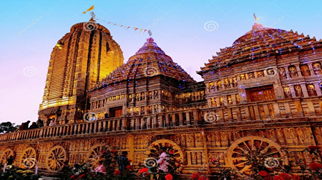

23rd January 2023 (7 Topics)
Context
Recently, Odisha’s Governor backed the entry of foreign nationals inside the Jagannath Temple in Puri, which converted into a debate and has triggered controversy.
About Jagannath Temple:
- The Jagannath Temple of Puri is an important Hindu temple dedicated to Lord Jagannath(a form of Vishnu), located on the eastern coast of India, in the state of Odisha.
- It is believed to have been constructed in the 12th century by King Anatavarman Chodaganga Deva of the Eastern Ganga Dynasty.
- Anantavarma Chodagangadevais also known for building the Sun temple of Konark and Puri is considered the cultural capital of Odisha.
- Jagannath Puri temple is called ‘Yamanika Tirtha’where, according to Hindu beliefs, the power of ‘Yama’, the god of death, has been nullified due to the presence of Lord Jagannath.
- This temple was called the “White Pagoda” and is a part of Char Dham pilgrimages.
- Badrinath
- Dwaraka
- Puri
- Rameswaram
- There are four gates to the temple-
- Eastern ‘Singhdwara’ which is the main gate with two crouching lions
- Southern ‘Ashwadwara’
- Western 'Vyaghra Dwara'
- Northern ‘Hastidwara’
- There is a carving of each form at each gate.
- In front of the entrance stands the Aruna stambha or sun pillar, which was originally at the Sun Temple in Konark.
|
About Annual Rath Yatra: The temple is famous for its annual Rath Yatra, or chariot festival.
|
Provisions for Temple Entry:
- Only Hindus are allowed inside the shrine to offer prayers to the temple deities in the sanctum sanctorum.
- It has been the practice for centuries even though there is no clearly articulated reason for it.
- Some historians believe that multiple attacks on the Temple by Muslim rulers might have led the servitors to impose restrictions on the entry of non-Hindus.
- Others have said that this was the practice from the time the Temple was built.
When Non-Hindus can visit Lord Jagannath?
- Patitapaban darshan:
- Lord Jagannath is also known as Patitabapan which literally means “saviour of the downtrodden”.
- So all those who are barred from entering the Temple because of religious reasons get the privilege of a darshan of the Lord in the form of Patitapaban at the Lion’s Gate.
- When the Lord emerges
- Jagannath comes to Bada Danda (the Grand Road) along with his siblings during the nine-day Rath Yatra (car festival) in June-July every year.
- This is an occasion when non-Hindus can have His darshan.
- As the deities go on a sojourn to the Gundicha temple, their birthplace, devotees from around the world throng Puri for a glimpse of the Lord.
| Recent controversy:
In 2011, a proposal by Pyari Mohan Mohapatra, then adviser to Chief Minister Naveen Patnaik, supported the entry of non-Hindus into the Temple to boost Odisha’s tourism potential, triggering a major controversy. Mohapatra had to withdraw his statement. |
Arguments in favour of Non-Hindus and Foreigners entering Temple:
- To promote Tourism in the state.
- To promote equality
- To promote India’s rich heritage in other countries
Constitutional backings:
Article 25(2) grants power to the State to enact the law on two distinct aspects.
- Article 25(2)(a)empowers the state to regulate “economic, financial, political or other secular activities which may be associated with religious practice”.
- Article 25(2)(b)enables the state to enact a law to prohibit the exclusion of ‘classes and sections’ of Hindu society to enter into Hindu temples of a public character and also make laws for social welfare and reform.
- Thus, the control of secular aspects associated with religion and the power to throw open Hindu temples to all classes and sections of society are distinct.
- The Constitution does not permit the state to assume ownership of properties belonging to religious institutions.
Legal provisions related to entry at religious places:
- In the Indian Young Lawyers Association v State of Kerala, the word morality used in Article 26(b) means constitutional morality.
- It is rooted in the fundamental postulates of human liberty, equality, fraternity, and dignity.
- Thus, as a consequence, the freedom of religion and, likewise, the freedom to manage the affairs of a religious denomination are subject to fundamental notions of constitutional morality, effectively opening the door for the application of Article 15(2) and Article 17, given the conditions enumerated within the clauses are satisfied.
- The anti-exclusion principle, i.e., Article 15(2) raises questions about the lack of explicit mention of places of worship within the text of the provision.
More Articles


